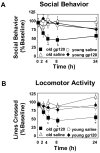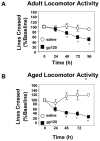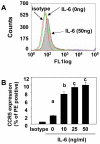Aging sensitizes mice to behavioral deficits induced by central HIV-1 gp120
- PMID: 17174449
- PMCID: PMC2374923
- DOI: 10.1016/j.neurobiolaging.2006.11.002
Aging sensitizes mice to behavioral deficits induced by central HIV-1 gp120
Abstract
The number of older adults with HIV-1 disease is increasing but little is known about how age influences behavioral deficits associated with HIV-1 infection. The purpose of this study was to determine in a murine model if aging influenced sickness behavior following central injection of HIV-1 gp120. In initial studies, behavioral deficits induced by acute and repeated intracerebroventricular (ICV) injection of gp120 were greater in aged mice than in adults. Furthermore, repeated ICV injection of gp120 increased hippocampal levels of IL-1 beta and IL-6 mRNA in aged mice but not in adults. To determine if IL-6, which is elevated in aged brain, affects expression of the gp120-binding target, CCR5, microglia (BV-2 cell line) were incubated with increasing concentrations of IL-6. Cell surface expression of CCR5 was increased by IL-6 in a dose-dependent manner. Additionally, IL-6 increased gp120-dependent chemotaxis. These results suggest that aging increases the sensitivity of mice to behavioral deficits caused by ICV gp120, perhaps by increasing expression of CCR5 and augmenting production of cytokines.
Figures





References
Literature Cited
-
- Barak O, Weidenfeld J, Goshen I, Ben-Hur T, Taylor AN, Yirmiya R. Intracerebral HIV-1 glycoprotein 120 produces sickness behavior and pituitary-adrenal activation in rats: Role of prostaglandins. Brain Behav Immun. 2002;16(6):720–35. - PubMed
-
- Barrientos RM, Higgins EA, Biedenkapp JC, Sprunger DB, Wright-Hardesty KJ, Watkins LR, Rudy JW, Maier SF. Peripheral infection and aging interact to impair hippocampal memory consolidation. Neurobiol Aging. 2005 - PubMed
-
- Dore GJ, Correll PK, Li Y, Kaldor JM, Cooper DA, Brew BJ. Changes to AIDS dementia complex in the era of highly active antiretroviral therapy. Aids. 1999;13(10):1249–53. - PubMed
-
- Ellis RJ, Deutsch R, Heaton RK, Marcotte TD, McCutchan JA, Nelson JA, Abramson I, Thal LJ, Atkinson JH, Wallace MR, Grant I, San Diego HIV Neurobehavioral Research Center Group Neurocognitive impairment is an independent risk factor for death in HIV infection. Arch Neurol. 1997;54(4):416–24. - PubMed
Web References
-
- CDC AIDS among persons aged greater than or equal to 50 years-United States, 1991-1996. MMWR. 1998;47:21–27. - PubMed
Publication types
MeSH terms
Substances
Grants and funding
LinkOut - more resources
Full Text Sources
Medical

